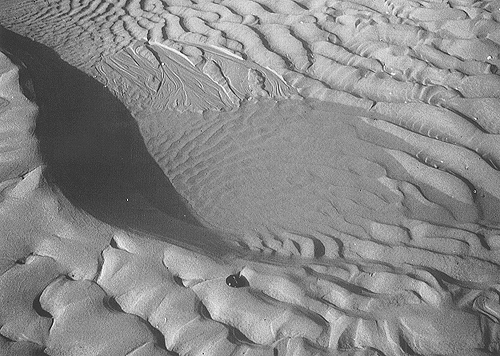
Bed forms: current ripples
Plate 29

Bed forms: current ripples
Plate 29
In this close-up, we can see the edge of a subaqueous dune and the adjacent trough where still water is trapped. The ripple morphology can also be appreciated. Ripples at the bottom of the pool are smaller and barely outlined; this is, in fact, an area protected from stronger eddies of the current (a shadow zone). The ripples are also arranged in a fanlike pattern (ripplefan).
Besides the flattening of ripples on the dune crest, we observe here two other types of modification of the subaqueous forms due to shallowing and emergence at low tide: 1) "microdeltas," i.e., small lobes of sand incised by tiny channels (rills) which indicate draining of water and sand toward the residual pool (upper left); 2) small ripples superposed to normal ones, with crests at 90° (see upper right). They are named interference ripples (see also plates 50-53), and should not be confused with other minor structures parallel to the flow, such as the grooves and spurs, which are visible in the foreground and in plate 30. Grooves and spurs are part of the equilibrium morphology of subaqueous ripples.
| Photo: G. G. Ori 1992. |